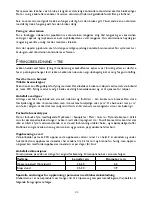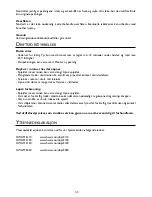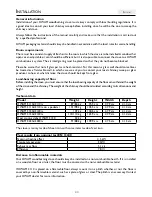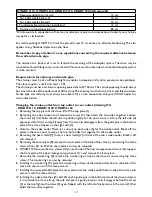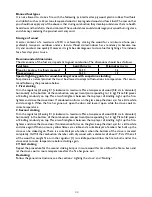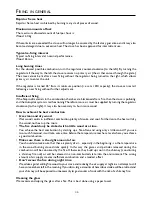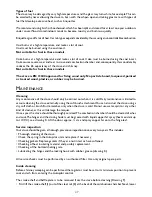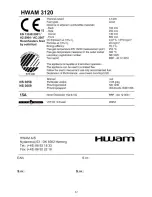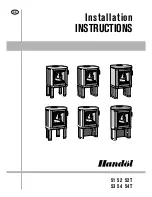
47
Types of fuel
The stove may be damaged by very high temperatures and the glass may turn white, for example. This can
be avoided by never allowing the stove to burn with the ashpan open and taking great care with types of
fuel that develop excessive heat, such as briquettes.
We recommend using birch or beechwood, which has been split and stored for at least one year outdoors
under cover. Wood stored indoors tends to become too dry and burn too quickly.
Briquettes give off a lot of heat. Certain types expand considerably, thus causing an uncontrollable combustion.
Coal burns at a high temperature and makes a lot of soot.
Coal must be burned using the coal insert.
Not suitable for fuel in these models.
Coke burns at a high temperature and makes a lot of soot. Coke must be burned using the coal insert.
Coke causes severe wear and tear to stove and combustion chamber and, consequently, this considerably
reduces the life expectancy of the stove and chimney.
Not suitable for fuel in these models.
The stove is EN 13240 approved for firing wood only. No particle board, lacquered, painted
or treated wood, plastics, or rubber may be burned.
m
aIntenance
Cleaning
Any maintenance of the stove should only be carried out when it is cold. Daily maintenance is limited to
vacuum cleaning the stove externally, using the soft brush attachment. You can also dust the stove using a
dry, soft cloth or brush. But remember, only when the stove is cold. Do not use water, spirit or any other
kind of cleaner, as this will damage the lacquer.
Once a year, the stove should be thoroughly serviced. The combustion chamber should be cleared of ashes
and soot. The hinges and the closing hook must be greased with liquid copper fat spray (heat-resistant up
to 1100°C), see drawing K. Lift the door approx. ½ cm and spray copper fat onto the hinge leaf.
Service inspection
Your stove should be given a thorough, preventive inspection once every two years. This includes:
• Thorough cleaning of the stove.
• Check the spring in the Autopilot unit and replace if necessary.
• Checking gaskets. Replace gaskets if they are not intact or have softened.
• Checking of heat insulating material and possibly replacement.
• Checking of the bottom/shaking grate.
• Lubricating the hinges and the locking hook with cobber grease (drawing K).
All service checks must be performed by an authorised fitter. Use only original spare parts.
Inside cleaning
Before chimney sweeping can be performed, the regulator must be set to its minimum position to prevent
soot and ash from entering the Autopilot control.
The smoke shelf and baffle plate is to be removed from the stove before cleaning (Drawing F).
• First lift the smoke shelf (1) out of the steel rail (2) at the back of the combustion chamber. Next, lower
Summary of Contents for 3110
Page 2: ...2 ...
Page 4: ...4 B C A D 11 12 14 14 15 3 1 1 4 45 4 3 2 1 9 11 10 17 1 6 5 7 8 2 3 15 4 16 4 3 14 12 13 ...
Page 5: ...5 F 6 2 1 3 4 5 G 3 0 E 1 ...
Page 6: ...6 1 6 6 7 4 5 9 8 2 3 H1 10 10 11 ...
Page 7: ...7 H2 ...
Page 8: ...8 K ...
Page 50: ...50 ...
Page 51: ...51 ...
Page 52: ...52 ...
Page 53: ...53 ...
Page 54: ......
Page 55: ......


